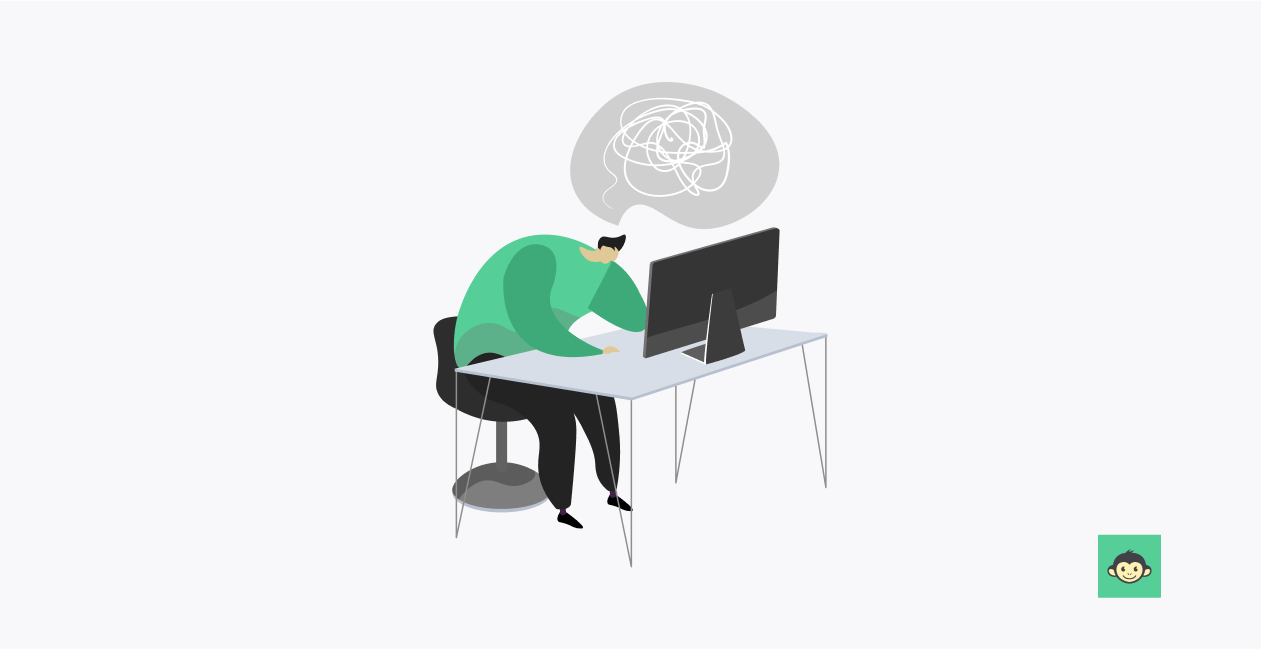5 Ways to manage stress in the workplace: Top tips to create a productive workplace

Picture this: It's Monday morning, and you find yourself facing a stack of urgent emails, a to-do list that seems to have a mind of its own, and a looming deadline breathing down your neck.
Sound familiar? For most of us, work can often be a whirlwind of busyness and frustration, where stress becomes an unwelcome companion. The demands of a job, the relentless pace, and the constant pressure all take a toll on us. Stress is knocking on our door, and it's affecting her productivity and overall well-being.
Work can get busy and frustrating, we know. Well, that’s why we’re here to talk about how stress can often be an unwelcome companion, especially in the workplace. But fear not! We'll also provide you with five top tips and best practices to help create a productive and stress-free work environment.
Let's dive into these strategies that go beyond mere survival, leading you towards a workday filled with productivity, fulfillment, and, most importantly, a sense of balance.
What is stress at work?

Before diving into our stress-busting strategies, let's define what stress at work really is. It's that feeling of being overwhelmed, tense, or anxious due to various factors related to your job. It can stem from heavy workloads, tight deadlines, challenging colleagues, or even long commutes. In fact, stress at work is more common than you might think.
According to the American Institute of Stress, 80% of workers feel stress on the job, and nearly half of them say they need help in managing it. The consequences of unchecked workplace stress can be dire, leading to decreased productivity, burnout, and even health problems.
How does stress at work affect productivity and employee engagement?

Stress at work can have a profound impact on both productivity and employee engagement. When employees are stressed, their ability to perform and engage effectively in their job roles can be significantly compromised. Here's how stress can affect these key aspects of the workplace:
Decreased productivity
Stress can lead to a decrease in concentration and focus. Employees may find it challenging to complete tasks efficiently, leading to a decline in overall productivity. For instance, a stressed-out employee may take longer to complete a project, make more mistakes, or miss deadlines.
Increased absenteeism
Chronic stress can result in frequent absenteeism. Employees who are overwhelmed by stress may take more sick days or personal time off to cope with their emotional and physical well-being. This absenteeism can disrupt workflow and impact team dynamics.
Low employee morale
High levels of stress can lead to lower employee morale and job satisfaction. When employees are unhappy or stressed, they are less likely to feel engaged in their work, leading to a decrease in overall enthusiasm and commitment.
Reduced creativity and innovation
Stress can hinder creative thinking and problem-solving abilities. Employees who are feeling stressed out may struggle to come up with new ideas or innovative solutions to challenges, ultimately affecting the organization's ability to adapt and grow.
Higher turnover rates
Prolonged stress can drive employees to seek alternative employment opportunities. High turnover rates can be costly for organizations, not only in terms of recruitment and training expenses but also in the loss of valuable institutional knowledge and expertise.
Negative impact on team dynamics
Stressed employees may become irritable or experience mood swings, which can affect workplace relationships and team dynamics. This can lead to conflicts and reduced collaboration among team members.
What is stress management at work?

Stress management at work refers to the strategies and practices employed by individuals and organizations to identify, mitigate, and cope with stressors in the workplace effectively.
The goal is to create a work environment that supports employees in managing stress, improving their well-being, and enhancing overall job satisfaction. Here are some key components of a stress management program at work:
Identification of stressors
The first step in managing workplace stress is identifying the specific stressors that employees face. These stressors can vary widely, from heavy workloads and tight deadlines to interpersonal conflicts and inadequate resources.
Stress assessment
Organizations may conduct stress assessments or surveys to gauge employees' stress levels and understand the sources of stress within the workplace better.
Workplace policies and programs
Employers can implement policies and programs that promote a healthy work-life balance, offer mental health support, and create a supportive work environment. This may include flexible work arrangements, access to counseling services, and wellness initiatives.
Training and education
Providing employees with training on stress management techniques, resilience, and coping strategies can be beneficial. This equips them with the skills to navigate and manage stress effectively.
Promoting communication
Encouraging open and honest communication between employees and management is crucial. Employees should feel comfortable discussing their stress-related concerns and seeking support when needed.
Supportive leadership
Effective leadership plays a significant role in employee stress management. Leaders who lead by example, show empathy, and prioritize employee well-being can positively influence the work culture.
Promotion of work-life balance
Encouraging employees to maintain a healthy work-life balance is essential. This includes respecting boundaries, promoting vacation days, and discouraging excessive overtime.
Regular feedback
Providing constructive feedback and recognizing employees' contributions can boost morale and reduce stress.
Overall, stress management at work involves a combination of organizational policies, individual strategies, and a supportive workplace culture.
What are the causes of stress at work?

Stress at work can stem from a variety of factors, and it's important to recognize these causes to effectively address and manage workplace stress. Here are some common causes of stress at work:
- Workload and time pressure: Heavy workloads, tight deadlines, and a constant sense of urgency can lead to stress. Employees in stressful situations may struggle to manage their tasks within the given time frame.
- Unclear job expectations: When employees are unsure about their roles, responsibilities, or performance expectations, it can create stress and anxiety.
- Workplace conflicts: Interpersonal conflicts with colleagues or supervisors can be a significant source of stress. These conflicts can disrupt teamwork and create a hostile work environment.
- Lack of control: Feeling powerless or having limited control over one's work can contribute to stress. Employees who have no say in decision-making processes or work environments may experience frustration.
- Job insecurity: Fear of job loss or uncertain employment prospects can cause significant stress. This can be particularly pronounced during economic downturns or organizational restructuring.
- Bullying or harassment: Experiencing bullying, harassment, or discrimination in the workplace can be extremely distressing and emotionally draining.
- Inadequate resources: Insufficient tools, equipment, or support to perform one's job effectively can lead to stress. This includes not having access to necessary information or technology.
- Long commutes: Lengthy and stressful daily commutes can contribute to overall stress levels, as they eat into personal time and can be physically draining.
- Work-life imbalance: When the demands of work encroach on personal life and family time, it can lead to stress and burnout. Maintaining a healthy work-life balance is crucial.
- Lack of recognition and reward: Employees who feel undervalued or underappreciated for their contributions may experience stress. A lack of recognition can lead to job dissatisfaction.
- Organizational changes: Changes such as mergers, reorganizations, or shifts in leadership can create uncertainty and stress among employees.
- High expectations and perfectionism: Employees who set unrealistically high expectations for themselves or face excessive pressure to be perfect may experience chronic stress.
- Physical work environment: Uncomfortable or unsafe working conditions can contribute to stress. This includes issues like poor lighting, excessive noise, or inadequate ventilation.
- Health and safety concerns: In some industries, concerns about workplace and safety hazards and exposure to hazardous materials can be a significant source of stress.
- Lack of growth and development: A lack of opportunities for skill development, career advancement, or personal growth can lead to dissatisfaction and stress.
- Technological overload: Constant connectivity and the expectation to be available around the clock due to technology can blur the lines between work, friends and family and personal life, contributing to stress.
Benefits of stress management programs at work

Implementing stress management programs in the workplace can yield a multitude of benefits for both employees and the organization as a whole.
Enhanced employee resilience
Stress management programs empower employees with tools and techniques to bounce back from setbacks and challenges. This resilience extends to their personal lives, enabling them to better navigate life's ups and downs.
As employees become more resilient, they are not only better equipped to handle workplace stressors but also to cope with external pressures, resulting in a more well-rounded and adaptable workforce.
Better conflict resolution
Stress management training equips employees with valuable conflict resolution skills. They learn how to communicate effectively, empathize with others, and find collaborative solutions to disagreements.
This leads to a harmonious work environment, improved team dynamics, and a reduction in the negative impact of conflicts on productivity and morale.
Increased innovation
Stress management programs nurture a workplace culture where employees feel safe to express their creative ideas. With reduced stress, individuals are more open to brainstorming and thinking outside the box.
This boost in creativity and innovation not only benefits the organization's problem-solving capacity but can also lead to the development of novel products or services.
Greater job satisfaction
Stress management programs nurture a workplace culture where employees feel safe to express their creative ideas. With reduced stress, individuals are more open to brainstorming and thinking outside the box.
This boost in creativity and innovation not only benefits the organization's problem-solving capacity but can also lead to the development of novel products or services.
Enhanced problem-solving
Stress management programs equip employees with problem-solving techniques and strategies. They learn to approach challenges with a clear and focused mindset, resulting in more efficient issue resolution.
These enhanced problem-solving skills not only benefit employees individually but also contribute to the organization's overall efficiency and productivity.
Strengthened organizational culture
Organizations that invest in stress management programs send a clear message that employee well-being is a priority. This fosters a positive organizational culture characterized by trust, support, and open communication.
As employees feel valued and supported in their journey to manage stress, the overall work environment becomes more cohesive and harmonious.
Improved customer relations
Organizations that invest in stress management programs send a clear message that employee well-being is a priority. This fosters a positive organizational culture characterized by trust, support, and open communication.
As employees feel valued and supported in their journey to manage stress, the overall work environment becomes more cohesive and harmonious.
Regulatory compliance
In certain industries, regulatory bodies require organizations to implement stress management programs to ensure the well-being of employees.
By adhering to these regulations, organizations not only meet legal requirements but also demonstrate a commitment to their workforce's health and safety.
Reduced presenteeism
Stress management programs help to reduce "presenteeism," a situation in which employees are physically present but not fully productive due to stress. Addressing stress effectively ensures that employees are not just at work but actively engaged, leading to a more productive and efficient workforce.
Positive impact on family life
Reduced workplace stress can lead to a more harmonious personal life for employees. With lower stress levels, individuals are often happier and more engaged with their families, creating a positive spillover effect that enhances their work-life balance and overall well-being.
Higher employee retention
Organizations that prioritize stress management programs tend to experience higher levels of employee retention. A less stressful work environment encourages employees to stay with the organization for the long term, reducing turnover and the associated costs of recruitment and training.
Enhanced decision-making at all levels
Stress management programs have a positive impact not only on employees but also on organizational leadership. Reduced stress fosters a clearer and more informed decision-making process at all levels of the organization.
Leaders can make more strategic choices that benefit the company as a whole, leading to a more resilient and adaptable workplace.
What are the 4 A's of stress management?

The 4 A's of stress management are a set of practical steps individuals can take to effectively manage stress:
1. Acknowledge
The first step is recognizing and acknowledging that you are experiencing stress. Self-awareness is key to addressing the issue.
2. Assess
Identify the specific causes of your stress. Understanding the sources of stress can help you develop targeted strategies to manage it.
3. Adapt
Once you've identified the sources of stress, adapt by implementing strategies to cope with or mitigate those stressors. This may involve setting boundaries, seeking support, or making lifestyle changes.
4. Accept
Sometimes, certain stressors cannot be completely eliminated. In such cases, it's essential to accept what you cannot change and focus on managing your reaction to these stressors.
What are 5 effective ways and best practices to manage stress?

- Prioritize work-life balance: Set boundaries between work and personal life, take regular breaks, and use vacation days to take time off to recharge.
- Foster a supportive work environment: Encourage teamwork, open communication, and a culture that values employee well-being.
- Practice time management and prioritization: Use techniques like the Pomodoro technique, delegate tasks when possible, and organize your workload effectively.
- Provide opportunities for skill development: Offer training and growth opportunities to boost employee confidence and job satisfaction.
- Encourage physical and mental well-being: Promote exercise, healthy eating, and mental health support to enhance employee well-being.
Importance of mental health at work

Mental health at work is paramount as it directly impacts employee well-being, job performance, and overall workplace dynamics. Prioritizing mental health:
Reduces stress and the risk of burnout
Prioritizing mental health at work creates an environment where employees feel supported in managing their stress. Stress management initiatives and resources help employees identify and cope with stressors effectively.
This, in turn, reduces the risk of burnout, which is characterized by emotional exhaustion, decreased performance, and a feeling of being overwhelmed. When employees can proactively address stress, they are more likely to maintain their well-being, stay motivated, and avoid the detrimental effects of burnout.
Improves productivity and engagement
Mental health and productivity are closely intertwined. When employees feel mentally and emotionally well, they can work with increased focus and efficiency. A positive mental state leads to higher levels of engagement, as employees are more motivated to contribute their best effort.
They become fully immersed in their work, leading to improved job performance and greater dedication to the organization's goals. This, in turn, benefits the organization through increased productivity and a more committed workforce.
Enhances employee morale and job satisfaction
Prioritizing mental health contributes significantly to employee morale and job satisfaction. When employees feel that their mental health is valued, they tend to experience higher morale. They appreciate the organization's commitment to their well-being, leading to a more positive attitude toward their work.
This, in turn, results in increased job satisfaction, as employees are content with their roles, their contributions are recognized, and they feel supported in managing stress effectively.
Creates a positive workplace culture
A workplace that prioritizes mental health fosters a positive culture. Employees are encouraged to talk openly about their well-being, share their challenges, and seek help when needed.
This openness creates a supportive, understanding, and empathetic culture where colleagues and leaders alike care about one another's mental health. Such a culture is characterized by trust, collaboration, and a shared commitment to well-being, which enhances overall workplace dynamics and promotes a sense of belonging and inclusion.
Reduces absenteeism and turnover rates
By actively addressing mental health issues and managing stress effectively, organizations can significantly reduce absenteeism. Employees who feel supported in their mental health are less likely to take sick days or personal time off due to stress-related concerns. This leads to greater workplace stability and ensures that projects and tasks are not disrupted by frequent employee absences.
Additionally, prioritizing mental health also has a positive impact on reducing turnover rates. When employees are content with their mental health support and job satisfaction, they tend to stay with the organization longer, lowering the costs associated with recruitment and training of new personnel. This stability further reinforces the positive workplace culture and productivity.
7 Mental health initiatives to try to reduce stress for employees

Mental health awareness campaigns
Mental health awareness campaigns are a proactive way to address mental health issues within the workplace. These campaigns aim to educate employees about various aspects of mental health, such as stress, anxiety, depression, and the available resources for support.
By increasing awareness, employees are more likely to recognize when they or their colleagues may be struggling, reducing the stigma associated with mental health challenges.
Employee assistance programs (EAPs)
Employee Assistance Programs are a valuable resource that organizations can provide to their employees. EAPs offer confidential counseling and support services, allowing employees to access professional assistance for a wide range of issues, including stress, personal problems, or work-related challenges.
This confidential and non-judgmental support can be a lifeline for employees facing mental health issues, helping them cope effectively and find solutions to their challenges.
Flexible work arrangements
Flexible work arrangements, such as remote work options or flexible hours, allow employees to better manage their work-life balance and accommodate their unique needs.
These arrangements recognize that employees have responsibilities and priorities outside of work, and by providing flexibility, organizations reduce stress associated with rigid work schedules. This initiative enhances employee well-being, reduces stress, and often results in increased job satisfaction and productivity.
Stress management workshops
Stress management workshops are proactive in equipping employees with the knowledge and skills to manage stress effectively. These workshops offer practical guidance on stress management techniques, time management, mindfulness, and relaxation exercises.
By providing employees with the tools they need to cope with stress, organizations empower them to take control of their mental health and well-being.
Wellness challenges
Wellness challenges are a fun and engaging way to promote mental health and overall well-being. These challenges can focus on various aspects, including physical activity, healthy eating, and stress reduction. They encourage employees to adopt healthier lifestyles, manage stress, and form positive habits.
Mental health days
Allowing employees to take occasional mental health days is a critical initiative for reducing stress. These days allow employees to step back from work when they are feeling overwhelmed or experiencing high levels of stress.
By acknowledging the need for mental health days, organizations send a message that employees' well-being is a priority and that it's acceptable to prioritize self-care when needed.
Peer support networks
Encouraging employees to connect with peers who can provide emotional support creates a valuable network within the workplace. Peer support networks can be a source of understanding, empathy, and encouragement.
Employees facing stress or mental health challenges can share their experiences and receive guidance and emotional support from colleagues who have gone through similar situations.
Conclusion
In conclusion, prioritizing stress management at work through programs, the 4 A's approach, and effective strategies can lead to numerous benefits for both employees and organizations. It enhances well-being, productivity, and engagement while reducing absenteeism and turnover.
Furthermore, mental health initiatives play a crucial role in reducing stress and fostering a positive workplace culture. By taking proactive steps to address employees and manage stress well, organizations can create a healthier and more productive work environment.
With that said, measuring the level of stress at work plays a crucial role in curbing it in the first place. This is where an employee engagement survey software like CultureMonkey comes into the play.
CultureMonkey let’s leaders listen, analyze, and sustain employee engagement at work. Visit us now and see how you can create a stress free workplace that is productive and strives for growth.



